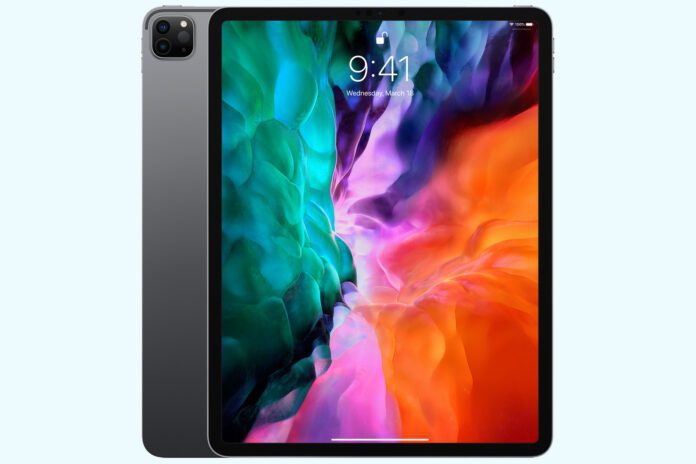You can tell that Apple’s newest iPad is different from the minute you take it out of the box. For one thing, the home button is gone. On the back is a row of three tiny contacts. Turn it on, and it’s essentially all screen.
Apple has brought many of the latest changes from the iPhone 11 Pro to the iPad, and with it you get Face ID and gesture controls. Like its predecessor, it uses a USB C connector instead of the Lightning cable used by the iPhone. This iPad includes some new capabilities, notably built-in LIDAR (light direction and ranging) for measuring distance from the rear of the tablet. It contains two cameras, one for wide-angle photos and a second for ultra-wide-angle images.
Display
The screen, which Apple calls its Liquid Retina Display, has a resolution of 2388 by 1668 pixels in the 11-inch version I tested. The display features an ultra-wide P3 color gamut and a 120 Hz refresh rate, making on-screen motion very smooth.
Facial ID
A big change from earlier iPads is the use of the Face ID system, similar to the facial recognition on recent iPhones. However, it seems to be faster than what I’ve seen on the iPhone 11 Pro, likely due to the improvements in the TrueDepth camera.
Processing power
This iPad uses Apple’s A12Z Bionic 8-core 64-bit processor that includes an embedded M12 coprocessor. The processor is designed so that four of the processors are designed for performance and the other four for efficiency. Apple says that this new iPad Pro has desktop-like performance. That would be an unfair comparison if only because my lab has desktop computers so old Windows 10 won’t even run on them.
Better physical handling
In use, this new iPad feels substantive in your hand. The squared edges make the iPad easier to grip than the rounded edges of earlier generations. I didn’t find this iPad slipping out of my hands as has been the case with earlier versions. In use, it’s highly responsive, surprisingly so in a few cases while I was trying to move icons to create folders, when it sometimes tried to create a folder before I was ready.
The screen is bright and very easy to read. The screen is clear enough that I could easily read the tiny print Apple is so fond of. The colors on photos are true to the original, and videos from a variety of sources run smoothly and clearly. You can shoot 4K video at frame rates up to 60 fps.
Cameras
The still cameras shoot 12 megapixels for the wide and 10 megapixels for the ultra wide. The wide camera has a maximum aperture of f1.8, which is remarkable on a tablet. It has a 2x optical zoom and a 5x digital zoom. The front camera supports up to 7 megapixels and supports HDR (high dynamic range).
Supports AR
The combination of the rear cameras and the LIDAR is intended to support augmented reality, and Apple includes hooks for developers so that apps can make use of the capability. Apple’s Measure app uses them, and I found that measurements taken with this iPad were more accurate than with earlier iPad Pro tablets.
Gigabit-class LTE connectivity
This iPad Pro supports WiFi 6 and what Apple calls gigabit class LTE. Testing of transfer speeds using a WiFi 6 router from Asus to a gigabit fiber network showed speeds in excess of 750 megabits per second. This is the same network that allowed an iPhone 11 Pro to demonstrate speeds of just under a gigabit per second. However, these speeds are subject to network conditions. I have no doubt that the iPad could reach similar speeds given better network conditions. We could not test gigabit class LTE, primarily because it doesn’t seem to exist in the Washington, DC, area where this test was conducted. This iPad does not appear to support 5G, which is available in the test area.
Magic Keyboard is magnetized
This iPad Pro was delivered with Apple’s Magic Keyboard. This device attaches to the rear of the tablet using strong magnets. When it’s attached, three copper contacts engage the matching three on the back of the iPad. The keyboard has a USB C connector into which you can plug the charging cable, which lets you get power while also using the USB C connector on the bottom of the tablet for other purposes, such as attaching a monitor.
The keyboard is well designed and easy to use. It’s better than the type-cover that came with earlier iPad Pro models. Apple also supplied a second-generation Pencil, which appears unchanged from the Apple Pencil we tested previously.
Supports a mouse
One welcome change is that the iPad now supports a mouse. You can use a USB mouse or a Bluetooth mouse such as Apple’s Magic Mouse. I tested that capability with a Logitech M515 Bluetooth mouse and with a Microsoft Laptop Mouse. Both worked properly. However, this is actually a function of iPadOS 13.4, and you can now use a mouse with other iPads. I also used that capability with a first-generation iPad Pro. This is a badly needed feature for iPads, and even though it’s presented as an accessibility feature, it’s a real improvement.
Pricing
The 11-inch iPad Pro starts at $799.00. The device I tested, which included 1 terabyte of memory and cellular support, sells for $1449.00. There’s also a 12.9-inch iPad Pro that starts at $999.00.
This iPad is worth the upgrade cost.
Wayne Rash, a former executive editor of eWEEK, is a longtime contributor to our publication and a frequent speaker on business, technology issues and enterprise computing.
